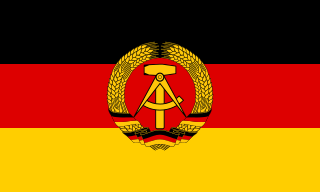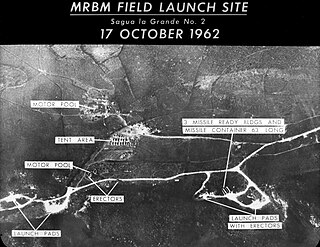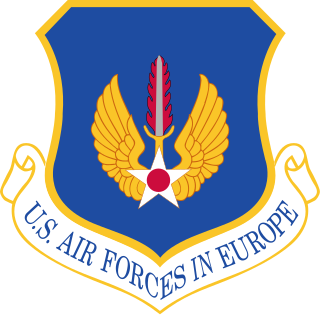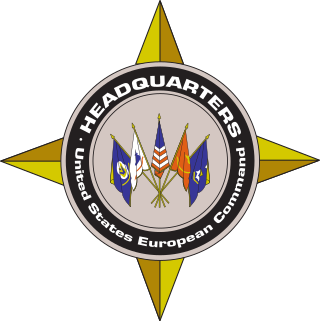Related Research Articles

The Berlin Wall was a guarded concrete barrier that physically and ideologically divided Berlin from 1961 to 1989. Construction of the wall was commenced by the German Democratic Republic on 13 August 1961. The Wall cut off West Berlin from surrounding East Germany, including East Berlin. The barrier included guard towers placed along large concrete walls, accompanied by a wide area that contained anti-vehicle trenches, beds of nails and other defenses. The Eastern Bloc portrayed the Wall as protecting its population from fascist elements conspiring to prevent the "will of the people" from building a socialist state in East Germany.

East Germany, officially the German Democratic Republic, was a country that existed from 1949 to 1990, the period when the eastern portion of Germany was part of the Eastern Bloc during the Cold War. Commonly described as a communist state in English usage, it described itself as a socialist "workers' and peasants' state". It consisted of territory that was administered and occupied by Soviet forces following the end of World War II—the Soviet occupation zone of the Potsdam Agreement, bounded on the east by the Oder–Neisse line. The Soviet zone surrounded West Berlin but did not include it and West Berlin remained outside the jurisdiction of the GDR.

West Berlin was a political enclave which comprised the western part of Berlin during the years of the Cold War. Although no specific date on which the sectors of Berlin occupied by the Western Allies became "West Berlin", 1949 is widely accepted as when the name was adopted. West Berlin aligned itself politically with the Federal Republic of Germany and was directly or indirectly represented in its federal institutions.

German reunification was the process in 1990 in which the German Democratic Republic (GDR) became part of the Federal Republic of Germany (FRG) to form the reunited nation of Germany.

World War III and the Third World War are names given to a hypothetical third worldwide large-scale military conflict subsequent to World War I and II. The term has been in use since at least as early as 1941. Some have applied it loosely to refer to limited or smaller conflicts such as the Cold War or the War on Terror, while others assumed that such a conflict would surpass prior world wars both in its scope and in its destructive impact.

Checkpoint Charlie was the best-known Berlin Wall crossing point between East Berlin and West Berlin during the Cold War (1947–1991), as named by the Western Allies.

Brinkmanship, or brinksmanship, is the practice of trying to achieve an advantageous outcome by pushing dangerous events to the brink of active conflict. The tactic occurs in international politics, foreign policy, labor relations, and in contemporary military strategy by involving the threat of nuclear weapons, and high-stakes litigation. The maneuver of pushing a situation with the opponent to the brink succeeds by forcing the opponent to back down and make concessions. That might be achieved through diplomatic maneuvers by creating the impression that one is willing to use extreme methods rather than concede.

After the defeat of Germany in World War II on 8 May 1945, the country was divided between the two global blocs in the East and West, a period known as the division of Germany. Germany was stripped of its war gains and lost territories in the east to Poland and the Soviet Union. At the end of the war, there were some eight million foreign displaced persons in Germany; mainly forced laborers and prisoners; including around 400,000 from the concentration camp system, survivors from a much larger number who had died from starvation, harsh conditions, murder, or being worked to death. Over 10 million German-speaking refugees arrived in Germany from other countries in Central and Eastern Europe. Some 9 million Germans were POWs, many of whom were kept as forced laborers for several years to provide restitution to the countries Germany had devastated in the war, and some industrial equipment was removed as reparations.

The Cold War was a period of geopolitical tension between the Soviet Union and the United States and their respective allies, the Eastern Bloc and the Western Bloc, after World War II. Historians do not fully agree on the dates, but the period is generally considered to span the 1947 Truman Doctrine to the 1991 dissolution of the Soviet Union. The term "cold" is used because there was no large-scale fighting directly between the two superpowers, but they each supported major regional conflicts known as proxy wars. The conflict was based around the ideological and geopolitical struggle for global influence by the two powers, following their temporary alliance and victory against Nazi Germany in 1945. The doctrine of mutually assured destruction (MAD) discouraged a pre-emptive attack by either side. Aside from the nuclear arsenal development and conventional military deployment, the struggle for dominance was expressed via indirect means such as psychological warfare, propaganda campaigns, espionage, far-reaching embargoes, rivalry at sports events and technological competitions such as the Space Race.

The Cold War (1953–1962) discusses the period within the Cold War from the death of Soviet leader Joseph Stalin in 1953 to the Cuban Missile Crisis in 1962. Following the death of Stalin, new leaders attempted to "de-Stalinize" the Soviet Union causing unrest in the Eastern Bloc and members of the Warsaw Pact. In spite of this there was a calming of international tensions, the evidence of which can be seen in the signing of the Austrian State Treaty reuniting Austria, and the Geneva Accords ending fighting in Indochina. However, this period of good happenings was only partial with an expensive arms race continuing during the period and a less alarming, but very expensive space race occurring between the two superpowers as well. The addition of African countries to the stage of cold war, such as the Democratic Republic of the Congo joining the Soviets, caused even more unrest in the west.

The Treaty on the Final Settlement with Respect to Germany, or the Two Plus Four Agreement, was negotiated in 1990 between the Federal Republic of Germany and the German Democratic Republic, and the Four Powers which occupied Germany at the end of World War II in Europe: France, the Soviet Union, the United Kingdom, and the United States. In the treaty, the Four Powers renounced all rights they held in Germany, allowing a reunited Germany to become fully sovereign the following year. At the same time, the two German states agreed to confirm their acceptance of the existing border with Poland, and accepted that the borders of Germany after unification would correspond only to the territories then administered by West and East Germany, with the exclusion and renunciation of any other territorial claims.

The United States Air Forces in Europe – Air Forces Africa (USAFE-AFAFRICA) is a United States Air Force major command (MAJCOM) and a component command of both United States European Command (USEUCOM) and United States Africa Command (USAFRICOM). As part of its mission, USAFE-AFAFRICA commands U.S. Air Force units pledged to NATO, maintaining combat-ready wings based from Great Britain to Turkey. USAFE-AFAFRICA plans, conducts, controls, coordinates and supports air and space operations in Europe, parts of Asia and all of Africa with the exception of Egypt to achieve U.S. national and NATO objectives based on taskings by the two combatant commanders.

The United States European Command (EUCOM) is one of the eleven unified combatant commands of the United States military, headquartered in Stuttgart, Germany. Its area of focus covers 21,000,000 square miles (54,000,000 km2) and 51 countries and territories, including Europe, Russia, Greenland, and Israel. The Commander of the United States EUCOM simultaneously serves as the Supreme Allied Commander, Europe (SACEUR) within NATO, a military alliance. During the Gulf War and Operation Northern Watch, EUCOM controlled the forces flying from Incirlik Air Base.

The Soviet War Memorial is one of several war memorials in Berlin, capital city of Germany, erected by the Soviet Union to commemorate its war dead, particularly the 80,000 soldiers of the Soviet Armed Forces who died during the Battle of Berlin in April and May 1945.

The Berlin Crisis of 1961 occurred between 4 June – 9 November 1961, and was the last major politic-military European incident of the Cold War about the occupational status of the German capital city, Berlin, and of post–World War II Germany. The Berlin Crisis started when the USSR launched an ultimatum demanding the withdrawal of all armed forces from Berlin, including the Western armed forces in West Berlin. The crisis culminated in the city's de facto partition with the East German erection of the Berlin Wall.
The following outline is provided as an overview of and topical guide to the Cold War:

The Berlin Blockade was one of the first major international crises of the Cold War. During the multinational occupation of post–World War II Germany, the Soviet Union blocked the Western Allies' railway, road, and canal access to the sectors of Berlin under Western control. The Soviets offered to drop the blockade if the Western Allies withdrew the newly introduced Deutsche Mark from West Berlin.

The Allied Museum is a museum in Berlin. It documents the political history and the military commitments and roles of the Western Allies in Germany – particularly Berlin – between 1945 and 1994 and their contribution to liberty in Berlin during the Cold War era.

This article outlines the history of the Common Security and Defence Policy (CSDP) of the European Union (EU), a part of the Common Foreign and Security Policy (CFSP).
The history of NATO started when British diplomacy set the stage to contain the Soviet Union and to stop the expansion of communism in Europe. The United Kingdom and France signed, in 1947, the Treaty of Dunkirk, a defensive pact, which was expanded in 1948 with the Treaty of Brussels to add the three Benelux countries and committed them to collective defence against any armed attack for fifty years. The British worked with Washington to expand the alliance into NATO in 1949, adding the United States and Canada as well as Italy, Portugal, Norway, Denmark, and Iceland. West Germany and Spain joined later.
References
- ↑ "Berlin Crisis". GlobalSecurity.org. Retrieved 7 June 2019.
- ↑ Pedlow, Gregory. "NATO and the Berlin Crisis of 1961: Facing the Soviets While Maintaining Unity" (PDF). archives.gov. National Archives. Retrieved 7 June 2019.
- ↑ "CODE NAME - LIVE OAK". www.nato.int. Retrieved 2019-04-23.